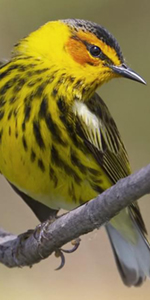| Cape May Warbler | ||
 |
Classification(s) : | Prey |
| Cat Name : | Canary | |
| Common Name : | Cape May Warbler | |
| Scientific Name : | Dendroica Tigrina | |
| Other Name(s) : | ||
| Physical Description : | The Cape May Warbler is a small songbird. The female has an olive-grey head and back, and the sides of her neck, throat, and breast are light yellow. Narrow grey streaks adorn her breast and sides, her rump is yellow, and there are two wingbars per wing. The male, on the other hand, is much more bright and colorful than the female. His throat and chest are yellow with smooth black stripes, and his crown and nape are black as well. He has chestnut cheek splotches and a large white patch on each wing, as well as under his tail. His rump is a bright yellow, as well as the sides of his neck, and he has black striping through his eye and on his back. |
|
| Physical Statistics : | Length: 4.7 – 5.1 Inches (12 – 13 Centimeters) |
|
| Behavior : | This small songbird lives in coniferous forest and thrives by eating insects off plants and other foilage. |
|
| Social Organization : | The Cape May Canary is usually solitary, but it will flock together during mating season and during an abundance of spruce budworms, their preferred food source. |
|
| Approval Level : | Mod; It is found throughout forests like, but it would rarely be found in open, un-forested areas. | |
| Kill Difficulty : | Low; It is relatively easy to kill because it has little defenses and small size. |
|
| Training Level : | Advanced; It can easily fly away, and has a loud alarm call. |
|
| Hunting Tactic : | Songbirds | |
| Food Quality : | Medium; What it lacks in size, it makes up for in nutrition. | |
